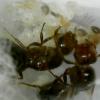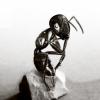So, I'm trying to look into building a formicarium for the future, or perhaps a fancier founding chamber for my recent queens. I like the sound of plaster, but it sounds like the S.invicta I have will chew through it and I'd be surprised if Pogonomyrmex couldn't either, which is a species I'm hoping to grab.
So, what's the difference between hydrostone and grout? I know there are different types of grout too, according to a forum here it said unsanded grout absorbs water a lot easier. But I've also seen people mixing crushed perlite with grout to make it more water absorbent but others not doing that at all. It seems when it's just a layer of grout, like putting it on a plastic nest.
So, grout probably doesn't need perlite if it's just a small layer of it?
I also heard hydrostone expanding. Does this happen when it absorbs water? Or when it's curing?
Any other information as far as these two materials go?
Also, say I just want to lay a layer of substrate, basically just glue a coating of sand along a surface as thinly as possible, what would you use to do that?

















